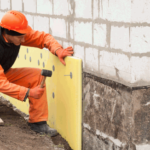Have you ever wondered if power washing can effectively remove wood stains? In this article, we will explore the process of power washing and wood staining, as well as whether power washing can indeed eliminate wood stains.
We will also discuss factors that can impact the effectiveness of power washing on wood stains and provide alternatives for removing stains from wood.
Discover tips on how to properly power wash wood to remove stains and important safety precautions to keep in mind. Let’s uncover the best methods for revitalizing your wood surfaces!
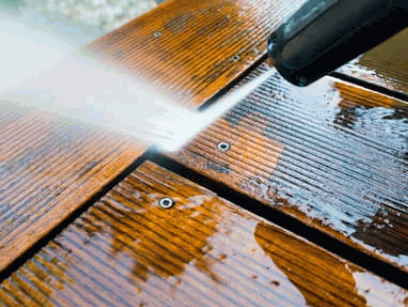
What Is Power Washing?
Power washing, also known as pressure washing, is a cleaning method that uses a high-pressure water spray to remove dirt, grime, and other tough stains from surfaces.
It is an effective way to clean various surfaces like driveways, decks, fences, and sidewalks, restoring their original appearance. The high-pressure water stream generated by specialized equipment can reach crevices and corners that are hard to clean with regular tools.
Power washing not only enhances the aesthetics of your property but also helps prevent damage caused by mold, mildew, and other contaminants that build up over time. Regular maintenance through power washing can prolong the lifespan of your surfaces.
Gain insights: How To Clean Window Sills
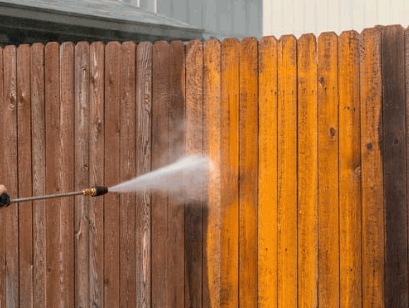
What Is Wood Staining?
Wood staining is a process of applying a coat of stain to wood surfaces, such as decks, to enhance their appearance and protect them from environmental elements.
One of the key benefits of wood staining is its ability to penetrate the wood surface, providing a protective barrier against moisture, UV rays, and general wear and tear. There are various types of stains available, including transparent, semi-transparent, and solid stains, each offering different levels of opacity and protection.
The application methods for wood staining can vary, from using a brush or roller to spraying. It’s important to prepare the wood surface properly by cleaning and sanding it before applying the stain to ensure even coverage and longevity of the finish.
Choosing the right stain for your deck can significantly prolong its lifespan and enhance its natural beauty. Staining not only adds color and depth to the wood but also helps prevent rot, mold, and decay, making it an essential step in wood protection and maintenance.
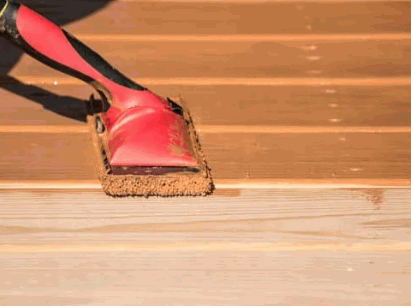
Can Power Washing Remove Wood Stain?
Power washing can effectively remove wood stains, especially tough stains, from surfaces like decks and patios.
One of the key advantages of power washing is its ability to strip away years of built-up grime, mold, and mildew that can make wood surfaces look worn and dingy.
To achieve optimal results when power washing wood stains, it’s essential to adjust the pressure settings accordingly – lower pressures work well for softer woods to prevent damage, while higher pressures are ideal for tougher stains.
When tackling tough stains like oil or grease, pre-treating the area with a specialized detergent can help loosen the stain before power washing.
What Factors Can Impact The Effectiveness Of Power Washing On Wood Stain?
The effectiveness of power washing on wood stain can be influenced by various factors, including the pressure levels (PSI), proximity of washing, surface material, and the condition of the wood.
In terms of pressure levels, finding the right balance is crucial – too high a PSI can cause damage to the wood, whereas too low may not yield the desired results. The proximity of the washing equipment also plays a significant role; being too close can lead to etching or splintering, while being too far may not effectively clean the surface.
The type of surface being washed is another critical consideration, as different materials such as softwood, hardwood, or composite wood require specific treatment methods. The condition of the wood, whether it’s stained, sealed, or weathered, will impact the effectiveness of the power washing process.
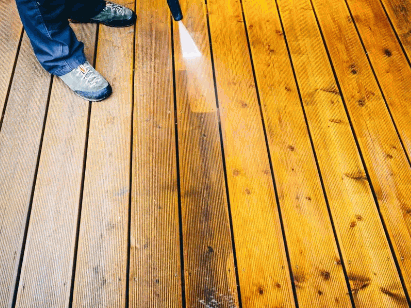
What Are The Alternatives To Power Washing For Removing Wood Stain?
Apart from power washing, there are alternative methods for removing wood stains, such as sanding, chemical stripping, and pressure washing with lower pressure settings.
In terms of sanding, involves using sandpaper or other abrasive tools to physically remove the stained layers from the wood surface. This method is effective for deeper stains or uneven surfaces but can be time-consuming and labor-intensive.
Chemical stripping, on the other hand, utilizes specialized products to dissolve and lift the stain without the need for extensive manual labor. While this technique is efficient, it requires careful handling of the chemicals and proper ventilation to avoid exposure risks.
Pressure washing with lower pressure settings offers a gentle yet effective approach to removing surface-level stains. By adjusting the pressure settings, you can control the intensity of the cleaning process, making it suitable for delicate wood surfaces.
Sanding
Sanding is a manual technique that involves using abrasive materials like 60-80 grit sandpaper to remove old stain layers before applying a new coat. It is particularly effective on dense wood species like Tigerwood.
In terms of the sanding process, it’s crucial to start with a lower grit sandpaper to effectively strip away the old stain without damaging the wood’s surface. As you progress, gradually move to higher grits such as 100-150 to smoothen out any rough patches left behind. Different wood types require specific sandpaper variations – softer woods like pine or cedar may benefit from finer grits, while harder woods like oak or mahogany might need coarser sandpaper. Choosing the right sandpaper grit is key to achieving a beautifully prepped surface for refinishing.
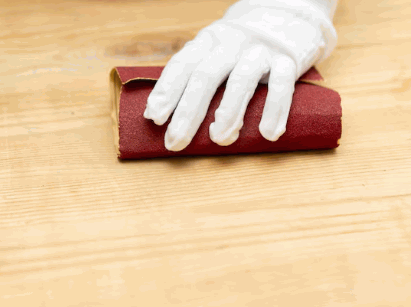
Chemical Stripping
Chemical stripping involves the use of specialized products like RAD PaintStrip Solid Stain Stripping Gel containing Oxalyc Acid to break down and remove old wood stains effectively.
During the process, it is crucial to wear protective gear such as gloves, goggles, and a respirator to shield oneself from the harsh chemicals. Proper ventilation in the work area is essential to prevent inhaling fumes and ensure a safe environment.
Environmental considerations play a significant role, with many modern wood stripping chemicals designed to be more eco-friendly, biodegradable, and less harmful to the planet.
This shift towards sustainable solutions aligns with the increasing awareness of the need to minimize the environmental impact of chemical processes in various industries.
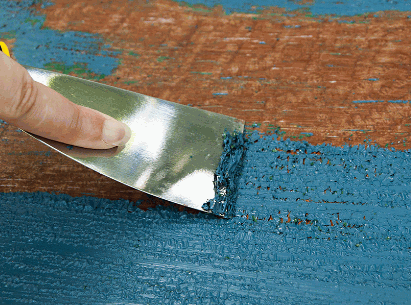
Pressure Washing With A Lower Pressure
Pressure washing with lower pressure settings, typically around 2400 PSI, can be an effective method for removing wood stains without causing damage to the wood fibers.
By using this technique, you are able to delicately lift off the surface stains and grime, revealing the natural beauty of the wood underneath. It is important to ensure that you have the right equipment for the job, such as the versatile Geyser Equipment, known for its reliable performance in tackling wood stain removal tasks with precision.
- When pressure washing wood surfaces, always keep the nozzle at a safe distance of about 12-18 inches to prevent any potential damage.
- Consider using a wider spray pattern to evenly distribute the pressure across the surface, ensuring a thorough clean.
- For stubborn stains, you can enhance the cleaning power by using a suitable wood cleaner or detergent in conjunction with the pressure washer.
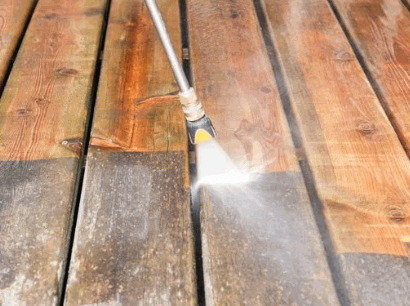
How To Properly Power Wash Wood To Remove Stain?
Properly power washing wood to remove stains involves using the right pressure and nozzle, applying a wood cleaner, following the grain of the wood, rinsing thoroughly, and allowing the wood to dry before applying a new stain.
To begin, it’s crucial to set the pressure on your power washer to a level suitable for wooden surfaces to avoid damage. Next, choose the appropriate nozzle attachment; a wider angle nozzle is recommended for wood to disperse the pressure evenly. When applying the wood cleaner, ensure it is specifically designed for the type of wood you are working with to prevent any adverse reactions. Always move the power washer in the direction of the wood grain to prevent splintering or damage. Thoroughly rinse the wood surface to remove all cleaner residue, preventing streaks or discoloration. Allow the wood to fully dry before applying a fresh coat of stain to achieve a professional finish.
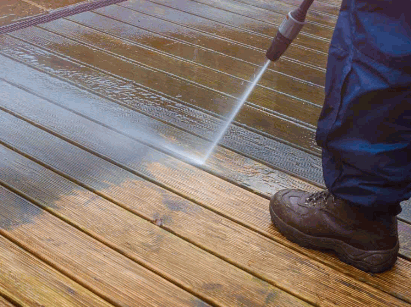
Choose The Right Pressure And Nozzle
Selecting the appropriate pressure and nozzle settings is crucial when power washing wood surfaces to ensure effective stain removal without causing damage to the wood fibers.
In terms of pressure washing equipment, understanding the importance of pressure and nozzle selection cannot be emphasized enough. The pressure setting determines the force with which water is sprayed onto the surface, while the nozzle controls the spray pattern and intensity.
Choosing the optimal pressure and nozzle combination is key to achieving the desired cleaning effect without compromising the integrity of the wood.
For different wood types, such as softwood or hardwood, it is essential to adjust the pressure and nozzle settings accordingly. Softwoods are more delicate and may require lower pressure to prevent damage, whereas hardwoods can withstand higher pressure levels.
Moreover, safety precautions should always be prioritized when operating pressure washing equipment. Wearing appropriate protective gear, maintaining a safe distance from the surface, and following manufacturer guidelines are essential to prevent accidents and ensure efficient cleaning results.
Use A Wood Cleaner
Applying a wood cleaner, such as a solution containing Sodium Hypochlorite, can help to lift dirt, grime, and stains from wood surfaces before power washing. Using a wood brightener can enhance the natural look of the wood.
Choosing the right wood cleaner is crucial as it not only deep cleans the surface but also prepares it for the power washing process, ensuring a thorough removal of embedded dirt and contaminants. Products like Oxalic Acid-based cleaners are excellent for tackling tough stains and mildew on wood. Incorporating a wood brightener post-cleaning not only revitalizes the wood’s appearance by restoring its natural color but also helps to protect it from UV damage and moisture, extending the lifespan of your outdoor wooden surfaces.
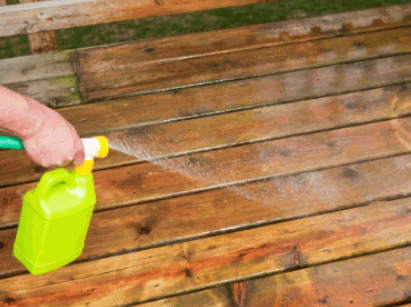
Follow The Grain Of The Wood
When power washing wood, it is essential to follow the natural grain of the wood to prevent damage and ensure thorough cleaning of the surfaces.
Working along the wood grain direction allows the water to penetrate evenly without causing splintering or gouging in the wood. By following this technique, not only can you clean more effectively, but you also reduce the risk of compromising the integrity of the wood structure.
To preserve the natural beauty and longevity of the wood, always adjust the pressure of the power washer to suit the wood type. Soft woods like cedar require lower pressure, while hardwoods can withstand higher settings.
Cleaning with the grain also minimizes the chances of streaking and uneven cleaning outcomes, ensuring a consistent and professional-looking result after power washing.
Rinse Thoroughly
After power washing wood surfaces, it is crucial to rinse the area thoroughly with clean water to remove any residue, cleaner, or loosened debris.
Rinsing is a critical step in wood cleaning as any leftover cleaning agents can have detrimental effects on the surface, leading to discoloration or damage over time. By thoroughly rinsing, you ensure that the wood is left clean and ready for the next stages of maintenance. Removing all cleaning agents is essential to prevent residue build-up, which can attract dirt and grime, undoing the initial cleaning work.
For optimal results, consider applying a wood sealer or protectant after washing. This additional treatment can provide a barrier against moisture, UV rays, and other environmental factors that can deteriorate the wood’s appearance and structure.
Allow The Wood To Dry
Once power-washed, it is essential to allow the wood surfaces to dry completely before applying a new stain to ensure proper adhesion and long-lasting finish.
Depending on the weather conditions, drying times can vary greatly. In hot and dry climates, the wood may dry much faster compared to humid or cooler environments. It is generally recommended to wait at least 24-48 hours for the wood to fully dry before proceeding with staining.
Ensuring that the surfaces are completely dry is crucial, as applying stain on damp wood can lead to a range of issues such as poor adhesion, uneven color distribution, and ultimately a shorter lifespan for the finish. It’s worth the wait to achieve a beautifully stained wood surface that will stand the test of time.
What Are The Safety Precautions For Power Washing Wood?
Ensuring safety while power washing wood involves wearing protective gear, testing a small area first, avoiding direct contact with the wood, and being mindful of surrounding plants and objects.
When power washing wood, it’s essential to start by checking the pressure settings on the equipment to ensure they are suitable for wooden surfaces.
Maintaining a safe distance from the wood while cleaning will prevent any potential damage or splintering.
Using gentle, sweeping motions instead of concentrated blasts of water can help evenly clean the surface without causing any harm.
Remember to inspect the wood for any existing damage before starting, as applying high pressure to weakened areas can lead to further destruction.
Wear Protective Gear
Before starting any power washing activities, it is essential to wear appropriate protective gear, such as goggles, gloves, and boots, to safeguard against potential injuries or exposure to cleaning agents.
Moreover,
- Protective gear not only provides physical protection but also ensures the safety of the eyes, hands, and skin during power washing tasks.
- Goggles shield the eyes from splashes and harsh chemicals, while gloves protect the hands from abrasive surfaces and cleaning solutions.
- Durable boots offer support and prevent slipping on wet surfaces, reducing the risk of accidents.
- Rental centers play a crucial role in offering a wide range of safety equipment, making it convenient for individuals to access high-quality gear without the need for significant investments.
Test A Small Area First
Before proceeding with full-scale power washing, it is advisable to test the equipment on a small, inconspicuous area of the wood surface, such as deck boards, to ensure the settings are suitable and do not cause damage.
Conducting a test patch is a crucial step that can prevent potential mishaps and ensure a successful cleaning process. To test the equipment, start by adjusting the pressure and flow settings to the manufacturer’s recommended levels. Next, direct the nozzle to the selected test area and begin spraying, keeping a consistent distance to maintain uniform coverage.
After completing the test patch, observe the results closely. Look for any signs of excessive wood damage, such as splintering or discoloration, which could indicate that the settings are too harsh. Conversely, if the test patch appears clean without causing any harm, it is a good indication that the equipment is set correctly for the larger power washing task.
Avoid Direct Contact With The Wood
To prevent potential damage to wood fibers and surfaces, it is essential to avoid direct contact with the wood during power washing, maintaining a safe distance and optimal angle for effective cleaning.
When using a power washer on wood surfaces, it is crucial to keep in mind that high-pressure water can be quite powerful and may lead to unintended consequences if not handled properly. The key is to strike a balance between power and caution, ensuring that the force of the water stream is sufficient to remove dirt and grime without causing harm.
- Experts suggest starting at least 2 feet away from the wood and gradually moving closer as needed, all the while being mindful of the pressure setting.
- Avoid lingering too long in one spot, as this can cause uneven cleaning and potential damage.
Incorporating these tips into your power washing routine can help protect the integrity of the wood while achieving optimal cleaning results.
Be Mindful Of Surrounding Plants And Objects
When power washing, it is crucial to be mindful of surrounding plants and objects to avoid accidental damage. Consider using plant-safe cleaning solutions like those containing sodium to protect vegetation.
It’s also wise to shield delicate plants from direct high-pressure water by covering them with a tarp or plastic sheet before starting the power washing process.
When dealing with objects like outdoor furniture or decorative items, consider moving them to a safe distance or covering them as well to prevent any potential harm.
Opt for gentle, eco-friendly detergents specifically formulated for plant care, to ensure the well-being of your garden.
Adjusting the pressure settings on the power washer can help safeguard fragile surfaces and minimize any risks of unintentional harm.
Remember, taking these precautionary steps can go a long way in maintaining the beauty of your outdoor spaces while ensuring the longevity of your plants and belongings.
Conclusion
Proper power washing techniques are essential for effectively cleaning deck surfaces and removing stubborn stains. By following safety precautions, selecting the right equipment, and using appropriate cleaning agents, you can restore the natural beauty of your wood surfaces with professional expertise.
In terms of rejuvenating your deck, the benefits of expert cleaning services cannot be overstated. Professionals not only have the necessary knowledge and experience to handle different types of wood surfaces, but they also use specialized tools and techniques to achieve optimal results.
Expert cleaners can assess the condition of your deck, identify any potential issues, and recommend the most suitable treatment to prolong its lifespan. This customized approach ensures that your deck receives the care it deserves, enhancing its overall appearance and durability.

